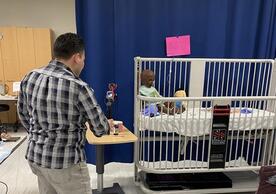
As the COVID-19 (coronavirus disease) pandemic spread with alarming ferocity during spring break, it became clear that students wouldn’t return to campus to finish the semester. The school needed to pivot to online instruction on a ticking clock, and the simulation experts jumped into action.
Simulation Director Virginia “Ginger” Sherrick, MSN, APRN, FNP-BC, RN-BC, CHSE leveraged every member of her five-person team to plan their strategy. “This happened extremely quickly,” Sherrick said. The group had just five days to adapt on campus clinical hours typically an in-person pedagogy for YSN into a virtual environment before the semester resumed.
They would be sewing the parachute on the way down, inventing and implementing new procedures to deliver Yale School of Nursing’s rigorous instruction without a pause or a decline in quality. To complicate their efforts, they also needed to abide by social distancing best practices, evacuate simulation spaces according to university-wide directives, and adhere to statewide ordinances calling for the elimination of nonessential travel.
In this simulation, Wendy Mackey and Marcie Gawel conduct a patient visit and demonstrate correct and incorrect provider behaviors. Linda Ghampson plays the role of the patient’s mother.
A Solution for Missing Clinical Hours
An important part of the preparation for the master’s of science in nursing comes from clinical rotations at hospitals, clinics, and other settings, where students become proficient in translating the knowledge gained in the classroom into practice. They get tangible training and mentoring from their dedicated preceptors, and they learn the skills of advanced practice nursing.
Sherrick knew that her team could continue to provide simulation experiences for the Graduate Entry Prespecialty in Nursing (GEPN) students by changing the delivery of simulation to a virtual environment. As future RNs, GEPNs replace a portion of their in-person clinical hours with simulations to complete their requirements and sit for the NCLEX boards. The state of Connecticut does not currently specify a percentage limit to successfully take the exam, but research shows that up to 50 percent of clinical hours can be simulated without any erosion in quality. Simulation cannot serve as a substitute for any of the 500 clinical hours needed for NP licensure, but it could keep students’ skills sharp and keep students engaged with the wider community.
The simulation team recorded roughly 20 lab topics and multiple simulation scenarios with faculty, hewing as closely as possible to the instructor’s original content. Countless man hours were spent behind the scenes processing and uploading files to the online platform, and collaborations with the Academic Support Unit (ASU) and IT services strengthened the end product. ASU guided faculty through synchronous and asynchronous approaches, offering guidance on how to best engage with students through an online medium.
Faculty Pivot Quickly to Sim
In addition to the staff’s herculean efforts to pull all the threads together, the school’s faculty also jumped in to help. Erin Morelli, MSN ’02, CNM, CLC and Wendy Mackey, MSN ’93 were at the forefront of faculty efforts, providing immediate participation and a tremendous amount of work to implement all the changes within their courses. They also continued making adaptations and providing feedback throughout the process, ensuring its success.
Mackey, a lecturer in pediatrics, transformed 90 clinical hours into virtual labs, virtual clinical groups, and simulations in less than a week and added a third simulation on the fly. “It was an extremely chaotic few days,” she said, “but students can still prepare, observe, and debrief each scenario, the same way we do in an in-person classroom.”
One of Mackey’s simulations is working with a child named Marcus who has a complex medical history. During the exercise, providers interact with Marcus and perform care functions. Afterward, nursing students need to analyze what went well and what went wrong.
“There are significant lessons that can be learned from this,” Sherrick said, “and this scenario has opened my mind up to how we can best move through other challenges.”
Smoothing out early glitches helped establish best practices and improve the user experience.
As COVID-19 continues to evolve, the Simulation team and the faculty are ready to adapt to the next phase of the pandemic and what comes next.
